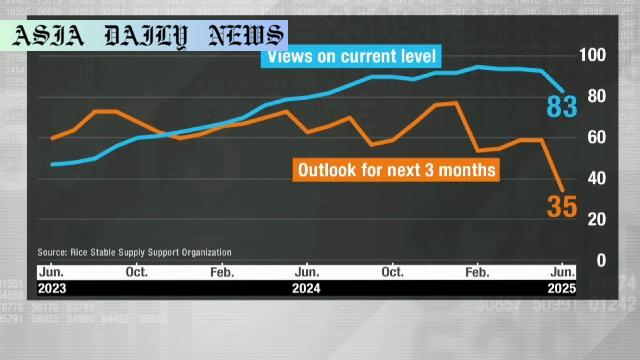Rice prices are expected to drop sharply over the next three months due to government stockpile distribution.

Introduction: A Historic Drop in Japan’s Rice Price Index
Japan’s rice market is facing a significant shift, as indicated by the latest survey released by the Rice Stable Supply Support Organization. The survey for June shows a severe drop in the rice price outlook index, which fell by 24 points, marking the largest margin of decline since data collection began in 2012. This decline, which rests on a scale of zero to 100, has settled the index at 35, sparking concerns among growers and wholesalers about the future of rice prices in Japan.
Factors Driving the Record Decline
The major cause of the decline is attributed to the government’s decision to release stockpiles of rice back into the market. This move comes amidst efforts to stabilize rice supply and manage costs, but it appears to have had a profound impact on the overall price expectation among stakeholders. The release of these stockpiles has introduced an oversupply condition, leading respondents to expect a further drop in rice prices over the next three months. The effects of this decision are clearly visible not only in the future outlook but also in the current market, where the index fell by 10 points to 83, highlighting immediate price concerns.
Implications for Growers and Wholesalers
For rice growers and wholesalers in Japan, this forecast is troubling. A lower price index signals reduced profitability and growing uncertainty about the market’s ability to stabilize in the near term. Many growers may find themselves grappling with the challenge of maintaining operations amidst falling revenues. On the other hand, wholesalers could face disruptions in their supply chain dynamics as they work to adapt to fluctuating prices. If the price drop continues over the coming months, the rice industry may require interventions to mitigate further economic fallout.
Broader Economic Impact
The decline in rice prices is not an isolated issue—it ties into wider economic concerns for the agricultural sector in Japan. As one of the country’s staple foods, rice plays a critical role in food security and agricultural policy. Any significant fluctuation in its pricing could affect not only growers and wholesalers but also consumers and government strategies for stockpile management. Lower rice prices may offer temporary reprieve for consumers amidst economic pressures but could strain the agricultural supply chain in the long term.
Conclusion and Potential Path Forward
In summation, Japan’s rice price index is experiencing a notable and historic downturn, tied directly to government actions and broader market dynamics. While the release of stockpiles aims to stabilize supply, its immediate effects paint a challenging picture for the months ahead. Reassessing strategies, enhancing communication between stakeholders, and exploring avenues for price stabilization could all play a part in addressing the situation going forward. How Japan’s rice industry adapts to these prevailing trends will define its economic stability in the sector for years to come.
Commentary
Unpacking the Record Decline in Japan’s Rice Prices
The sharp decline in Japan’s rice price index is both a cause for concern and a marker of the evolving dynamics in the country’s agricultural landscape. With prices expected to fall further in the coming months, it is imperative to consider the factors driving this decline and what it signifies for stakeholders throughout the supply chain. The government’s decision to release rice stockpiles, while intended to stabilize availability, appears to have created unintended consequences that ripple through the market.
Balancing Supply and Demand Amidst Oversupply
The oversupply condition created by the release of government stockpiles raises important questions about balancing supply and demand. Market mechanisms rely on an equilibrium between production, availability, and pricing. Overshooting supply often leads to drops in price, as evidenced by the latest survey results. This scenario can be particularly damaging to rice growers, who rely on stable or increasing prices for operational sustainability. While consumers might temporarily benefit from lower prices, the long-term consequences for the industry cannot be overlooked.
Adapting to Economic Challenges in Agriculture
The record decline in the rice price index also underscores the need for adaptability in Japan’s agricultural economic policies. Besides stabilizing prices, considering mechanisms to support farmers and stakeholders amidst declining revenues will prove critical. Encouraging diversification, exploring export opportunities, and improving overall resiliency in the face of pricing volatility might help cushion the shockwaves felt by this decline. At the policy level, striking a balance between managing stockpiles and ensuring market health is essential for sustainable growth.
The Road Ahead
Looking forward, the role of government regulators and industry stakeholders will be pivotal. Japan’s rice sector is a cornerstone of its agricultural economy, and the current trends warrant proactive solutions. Fostering communication within the supply chain, keeping consumer needs in mind, and implementing measured interventions will determine how well the industry rebounds. This challenge also offers an opportunity for Japan to re-evaluate its agricultural priorities and strengthen resilience against future disruptions.


